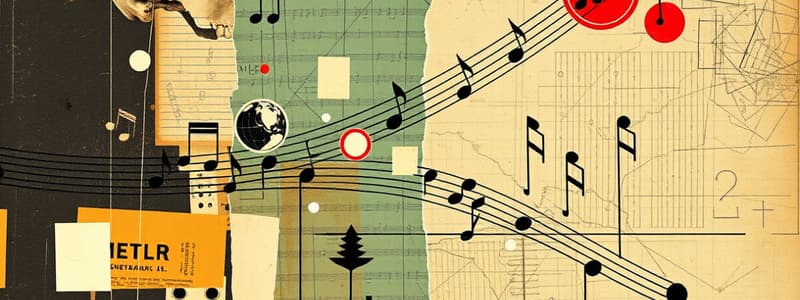Podcast
Questions and Answers
Which time signature is an example of simple meter?
Which time signature is an example of simple meter?
- 9/8
- 6/8
- 5/4
- 3/4 (correct)
What is the duration of a whole note?
What is the duration of a whole note?
- 8 beats
- 2 beats
- 1 beat
- 4 beats (correct)
What is the value of a quarter rest?
What is the value of a quarter rest?
- 1/2 beat of silence
- 1 beat of silence (correct)
- 4 beats of silence
- 2 beats of silence
How is a compound meter characterized?
How is a compound meter characterized?
Which of the following note values represents half of a beat?
Which of the following note values represents half of a beat?
Flashcards are hidden until you start studying
Study Notes
Notes and Rest Meter
Definition
- Meter: The rhythmic structure of a piece of music defined by the number of beats in each measure and the type of note that gets the beat.
Types of Meter
-
Simple Meter
- Divides the beat into two equal parts.
- Commonly uses quarter notes or eighth notes.
- Examples: 2/4, 3/4, 4/4.
-
Compound Meter
- Divides the beat into three equal parts.
- Typically feels like a "triplet" feel.
- Examples: 6/8, 9/8, 12/8.
-
Complex Meter
- Combines simple and compound meters, often varying within a piece.
- Examples: 5/4, 7/8.
Notes
- Whole Note: 4 beats.
- Half Note: 2 beats.
- Quarter Note: 1 beat.
- Eighth Note: 1/2 beat.
- Sixteenth Note: 1/4 beat.
Rests
- Whole Rest: 4 beats of silence.
- Half Rest: 2 beats of silence.
- Quarter Rest: 1 beat of silence.
- Eighth Rest: 1/2 beat of silence.
- Sixteenth Rest: 1/4 beat of silence.
Importance of Meter
- Establishes the underlying pulse of the music.
- Affects the feel and flow of a piece.
- Guides performers on rhythmic interpretation.
Reading Meter
- Time Signature: Appears at the beginning of a piece, indicating how many beats are in each measure and what note value is considered one beat.
- Top Number: Number of beats per measure.
- Bottom Number: Note value that represents one beat.
Practice
- Clapping or tapping to different meters helps in internalizing rhythmic patterns.
- Count out loud while playing music to reinforce understanding of meter and rhythm.
Definition of Meter
- Meter defines the rhythmic structure of music through the arrangement of beats in each measure.
- Indicates the note value that receives one beat.
Types of Meter
-
Simple Meter
- Beats are divided into two equal parts, predominantly using quarter or eighth notes.
- Common time signatures include 2/4, 3/4, and 4/4.
-
Compound Meter
- Beats are divided into three equal parts, often creating a triplet feel.
- Example time signatures include 6/8, 9/8, and 12/8.
-
Complex Meter
- A mixture of simple and compound meters, with varying structures throughout a piece.
- Examples include 5/4 and 7/8 time signatures.
Notes
- Whole Note: Represents 4 beats of sound.
- Half Note: Represents 2 beats of sound.
- Quarter Note: Represents 1 beat of sound.
- Eighth Note: Represents 1/2 beat of sound.
- Sixteenth Note: Represents 1/4 beat of sound.
Rests
- Whole Rest: Represents 4 beats of silence.
- Half Rest: Represents 2 beats of silence.
- Quarter Rest: Represents 1 beat of silence.
- Eighth Rest: Represents 1/2 beat of silence.
- Sixteenth Rest: Represents 1/4 beat of silence.
Importance of Meter
- Establishes the foundational pulse that drives the music forward.
- Influences the overall feel and character of a musical piece.
- Provides guidance for performers regarding rhythmic interpretation and expression.
Reading Meter
- Time signature, located at the beginning of a piece, indicates the number of beats per measure and the note value that constitutes one beat.
- Top Number: Indicates the count of beats within each measure.
- Bottom Number: Represents the note value that acts as the main beat tier.
Practice Techniques
- Engaging in clapping or tapping rhythms aids in the internalization of different meters.
- Vocalizing counts while playing music enhances understanding of rhythmic structures and meter.
Studying That Suits You
Use AI to generate personalized quizzes and flashcards to suit your learning preferences.




